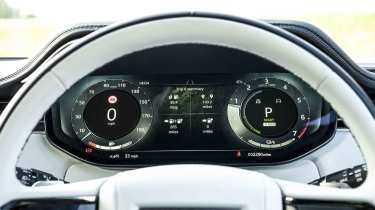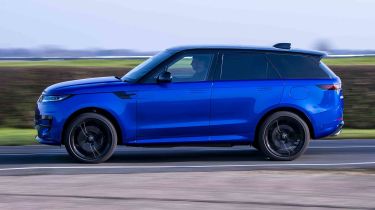Range Rover Sport - MPG, CO2 and running costs
Diesel power offers good real-world fuel economy, but the Sport PHEV models will be of more interest to business users

Land Rover offers mild-hybrid petrol and diesel versions of its Range Rover Sport, which helps to eke out a little extra efficiency from the 2.3-tonne luxury SUV (almost 2.7-tonnes in plug-in hybrid form). With the diesel models, the manufacturer claims that you should see 39.4mpg (on the WLTP combined cycle) from the D250, while the D300 and D350 are quite close to each other at 38.8mpg and 38.1mpg, respectively. Emissions range from 188g/km for the D250 to 194g/km for the D350.
The non plug-in P530 petrol model isn’t quite as economical, managing a mere 24.7mpg and flower-wilting emissions of 259g/km. That’s a minor improvement over its earlier iteration, but you’ll still be earning the ire of Greta Thunberg if you drive one.
The plug-in hybrid models offer the best fuel economy on paper, but based on our experience of plug-in hybrid cars, you’re unlikely to see numbers as high as 382.4mpg from the P460e, or the 362.2mpg from the P550e – even with regular charging.
| Model | MPG | CO2 | Insurance group |
| Sport D250 | 39.4mpg | 188g/km | 44 |
| Sport D350 | 38.1mpg | 194g/km | 50 |
| Sport P530 | 24.7mpg | 259g/km | 50 |
| Sport P460e | 382.4mpg | 17g/km | 50 |
Electric range, battery life and charge time
Both the P460e and P550e use a huge (for a plug-in hybrid) 38.2kWh battery pack. To put this into context, that’s larger than the 36.6kWh usable capacity of an entry-level MINI Cooper Electric. Given that the plug-in Sport weighs around a tonne more than the Cooper Electric and isn’t as aerodynamic, you won’t see electric range numbers close to what the MINI achieves, but the 70 miles of electric driving that’s quoted as the WLTP range is still a lot higher than most plug-in hybrids. However, it’s worth noting that Land Rover places a caveat on its website, stating that you should expect around 60 miles of electric range in real-world driving.
Used - available now

2022 Land Rover
Range Rover Sport
46,970 milesAutomaticPetrol2.0L
Cash £34,787
2014 Land Rover
Range Rover Sport
70,082 milesAutomaticDiesel3.0L
Cash £14,995
2021 Land Rover
Range Rover Sport
59,509 milesAutomaticDiesel3.0L
Cash £28,600
2025 Land Rover
Range Rover Sport
23,975 milesAutomaticDiesel3.0L
Cash £70,843It’s predicted to take around five hours to fully recharge the battery from flat to full when using a 7kW wallbox home charger, which is similar to the time it takes to top up the BMW X5 xDrive50e and Mercedes GLE 400e. The Sport does have a faster DC rapid charge function of up to 50kW if you need to charge faster than that, with a 0-80 per cent top-up time of 40 minutes.
| Model | Battery size | Range | Insurance group |
| Sport P460e | 38.2kWh | 73.3 miles | 50 |
| Sport P550e | 38.2kWh | 71.5 miles | 50 |
Tax
Business users will be better served by choosing one of the plug-in hybrid versions. The P460e has CO2 emissions from just 17g/km, putting it in the five per cent (six per cent 25/26 tax year) Benefit-in-Kind tax bracket. The more powerful P550e version also falls into the five per cent BiK rate because it has marginally worse emissions of 18g/km. In comparison, all petrol and diesel models are in the highest 37 per cent tax band.
There will be no escaping the hefty additional luxury car tax fee, because all versions breach the £40,000 threshold. You’ll need to pay this additional fee above the annual VED payment from the second time the vehicle is taxed until it is six years old.

Insurance
It should come as no surprise that the latest Range Rover Sport will be an expensive model to insure. Despite introducing a less expensive D250 S version, the Sport range goes from group 44 up to group 50 for the most powerful diesel, petrol and plug-in hybrid versions. That’s on par with rivals, with the Audi Q7 starting in group 45 and the BMW X5 in group 46.
Depreciation
The Range Rover Sport has often been a sought-after model, and that’s helped maintain healthy residual values over a typical three-year or 36,000-mile ownership period. The third-generation Sport is predicted to maintain between 56 to 61 per cent of its value, which is better than the Audi Q7; it’s only expected to hold on to between 43 to 54 per cent over the same period.
The plug-in hybrid P460e Dynamic SE model is the strongest performer, while the D350 Autobiography is the weakest.
To get an accurate valuation for a specific model, check out our valuation tool...







